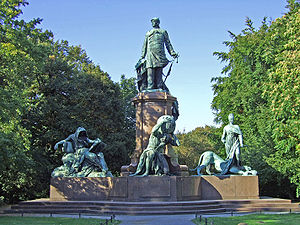
Bismarck Memorial
Encyclopedia

Tiergarten
Tiergarten is a locality within the borough of Mitte, in central Berlin . Notable for the great and homonymous urban park, before German reunification, it was a part of West Berlin...
in Berlin
Berlin
Berlin is the capital city of Germany and is one of the 16 states of Germany. With a population of 3.45 million people, Berlin is Germany's largest city. It is the second most populous city proper and the seventh most populous urban area in the European Union...
, is a prominent memorial statue
Statue
A statue is a sculpture in the round representing a person or persons, an animal, an idea or an event, normally full-length, as opposed to a bust, and at least close to life-size, or larger...
dedicated to Prince Otto von Bismarck
Otto von Bismarck
Otto Eduard Leopold, Prince of Bismarck, Duke of Lauenburg , simply known as Otto von Bismarck, was a Prussian-German statesman whose actions unified Germany, made it a major player in world affairs, and created a balance of power that kept Europe at peace after 1871.As Minister President of...
, Prime Minister
Prime Minister of Prussia
The office of Minister President or Prime Minister of Prussia existed in one form or another from 1702 until the dissolution of Prussia in 1947. When Prussia was an independent kingdom the Minister President or Prime Minister functioned as the King's Chief Minister and presided over the Prussian...
of the Kingdom of Prussia
Kingdom of Prussia
The Kingdom of Prussia was a German kingdom from 1701 to 1918. Until the defeat of Germany in World War I, it comprised almost two-thirds of the area of the German Empire...
and the first Chancellor of the German Empire
German Empire
The German Empire refers to Germany during the "Second Reich" period from the unification of Germany and proclamation of Wilhelm I as German Emperor on 18 January 1871, to 1918, when it became a federal republic after defeat in World War I and the abdication of the Emperor, Wilhelm II.The German...
. It was sculpted by Reinhold Begas
Reinhold Begas
Reinhold Begas was a German sculptor.Begas was born in Berlin, son of the painter Karl Begas. He received his early education studying under Christian Daniel Rauch and Ludwig Wilhelm Wichmann...
.
The massive memorial in Berlin portrays Bismarck in his ceremonial garb as Chancellor standing above statues of:
- AtlasAtlas (mythology)In Greek mythology, Atlas was the primordial Titan who supported the heavens. Although associated with various places, he became commonly identified with the Atlas Mountains in north-west Africa...
, showing Germany's world power status at the end of the 19th century; - SiegfriedSigurdSigurd is a legendary hero of Norse mythology, as well as the central character in the Völsunga saga. The earliest extant representations for his legend come in pictorial form from seven runestones in Sweden and most notably the Ramsund carving Sigurd (Old Norse: Sigurðr) is a legendary hero of...
, forging a sword to show Germany's strong industrial and military might; - GermaniaGermania (personification)Germania is the personification of the German Nation or the Germans as a whole, most commonly associated with the Romantic Era and the Revolutions of 1848, though the figure was later used by Imperial Germany. She is usually shown wielding the "Reichsschwert" . Additionally, she is sometimes shown...
pinning underfoot a panther, symbolizing the suppression of discord and rebellion; - a sibylSibylThe word Sibyl comes from the Greek word σίβυλλα sibylla, meaning prophetess. The earliest oracular seeresses known as the sibyls of antiquity, "who admittedly are known only through legend" prophesied at certain holy sites, under the divine influence of a deity, originally— at Delphi and...
reclining on a sphinxSphinxA sphinx is a mythical creature with a lion's body and a human head or a cat head.The sphinx, in Greek tradition, has the haunches of a lion, the wings of a great bird, and the face of a woman. She is mythicised as treacherous and merciless...
and reading the book of history.
The statue, along with the famous Berlin victory column
Berlin Victory Column
The Victory Column is a monument in Berlin, Germany. Designed by Heinrich Strack after 1864 to commemorate the Prussian victory in the Danish-Prussian War, by the time it was inaugurated on 2 September 1873, Prussia had also defeated Austria in the Austro-Prussian War and France in the...
, were once located in front of the Reichstag building before they were moved in 1938 by Adolf Hitler
Adolf Hitler
Adolf Hitler was an Austrian-born German politician and the leader of the National Socialist German Workers Party , commonly referred to as the Nazi Party). He was Chancellor of Germany from 1933 to 1945, and head of state from 1934 to 1945...
in his project to recast Berlin as Welthauptstadt Germania
Welthauptstadt Germania
Welthauptstadt Germania refers to the projected renewal of the German capital Berlin during the Nazi period, part of Adolf Hitler's vision for the future of Germany after the planned victory in World War II...
. The colossal statue weathered a marked amount of shrapnel damage during World War II
World War II
World War II, or the Second World War , was a global conflict lasting from 1939 to 1945, involving most of the world's nations—including all of the great powers—eventually forming two opposing military alliances: the Allies and the Axis...
, but has survived largely intact to the present day. In fact, the move probably saved the monument from total destruction, as the old garden in front of the Reichstag was completely obliterated in the war.

